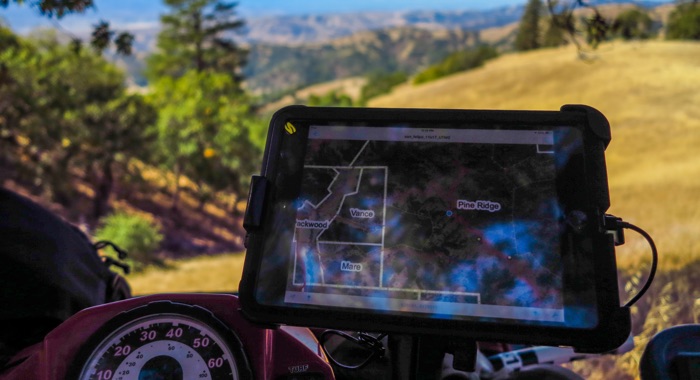A third of California is privately-owned forestland, woodland or grassland. From redwood forests on the north coast to oak savannas in the foothills, these “working wildlands” harbor native plants and animals and natural resources that shape California’s cultural and economic identity. The agricultural goods produced in these landscapes feed into a global market – from beef and dairy to building materials. Rangelands also help recharge groundwater. Healthy forests enhance water quality.
Harvest practices that are unsustainable, however, or conversion of these landscapes to more intensive land uses, can degrade habitats and reduce the flow of important benefits to people.
Working wildlands are what keep California stitched together ecologically. Their continued economic viability is key to the persistence of the ecological benefits they provide. Conservancy scientists work to figure out how to protect and enhance the function of these landscapes – as a critical network for nature.

H. Scott Butterfield (TNC), Jeanette K. Howard (TNC), Daniel Toews (TNC), Abigail Hart (TNC), Kathy Wood-McLaughlin
To meet the goals of California's 2014 Sustainable Groundwater Management Act (SGMA), more than 500,000 acres of irrigated agricultural land will need to be retired. TNC and partners…Bruce Markman, H. Scott Butterfield, Janet Franklin, Lloyd Coulter, Moses Katkowski, and Dan Sousa
Residual dry matter has been widely used to monitor grazing impacts across conservation grazing lands for more than 75 years, largely done with time-intensive, expensive, and hard-to-reproduce…A.D. Binley, J.O. Hanson, O.J. Robinson, G.H. Golet, J.R. Bennett
Monitoring biodiversity is critical for informing conservation but can also deplete resources available for management actions if the time and money available are limited. Freely available…Erin. E. Conlisk, Gregory H. Golet, Mark D. Reynolds, Nathan Elliot. and Matthew E. Reiter
Shorebirds are the second fastest declining group of birds in North America. To reverse this trend, The Nature Conservancy has been implementing BirdReturns, a habitat incentive program that pays…Nicholas A. Povak, Patricia N. Manley, Kristen N. Wilson
This study presents a methodology to integrate spatial assessments of current and future forest conditions to understand the potential to achieve desired conditions under climate change with ongoing…Kristen E. Dybala, Kristin. A. Sesser, Matthew E. Reiter, W. David Shuford, Gregory. H. Golet, Catherine Hickey, and Thomas Gardali
Conserving birds is a key goal for management of the Sacramento–San Joaquin Delta ecosystem, one of the largest estuaries on the Pacific Coast, and is likely to have effects for populations well…Grace C. Wu, Ryan A. Jones, Emily Leslie, James H. Williams, Andrew Pascale, Erica Brand, Sophie Parker, Brian Cohen, Joseph Fargione, Julia Souder, Maya Batres, Mary G. Gleason, Michael H. Schindel, Charlotte K. Stanley
This paper presents the results of the Power of Place-West project. The authors combined energy modeling with ecosystem and wildlife habitat data to determine the costs and impacts associated with…Erin E. Conlisk, Kristin B. Byrd, Elliot Matchett, Austin A. Lorenz, Michael Casazza, Gregory H. Golet, Mark D. Reynolds, Kristin A. Sesser, and Matthew E. Reiter
Landscape-scale wetland conservation requires understanding how wildlife responds to dynamic freshwater habitat availability. This study examined this for dabbling ducks by comparing habitat…Patricia N. Manley, Nicholas A. Povak, Kristen Wilson, Kristen Wilson, Mary Lou Fairweather, Vivian Griffey
The Blueprint is a set of strategy maps that identify opportunities for forest protection and adaptation across a 2.4-million-acre region of the central Sierra Nevada. It uses a novel application of…Gregory. H. Golet, Kristen. E. Dybala, Matthew. E. Reiter, Kristin. A. Sesser, Mark Reynolds, Rodd Kelsey
Shorebirds have declined precipitously in North America in the last 50 years, primarily due to the loss of wetlands. Incentive programs that pay farmers to create temporary wetland habitat on idled…Roland Geyer, Jenna Gavigan, Alexis M. Jackson, Vienna R. Saccomanno, Sangwon Suh, Mary G. Gleason
Synthetic microfibers are the most prevalent type of microplastic and apparel washing is a major source of microfiber pollution. Using California as a case study to estimate the magnitude of…O.J. Robinson, V. Ruiz-Gutierrez, M.D. Reynolds, G.H. Golet, M. Strimas-Mackey and D. Fink
Information on species’ habitat associations and distributions, across wide spatial and temporal scales, is fundamental for guiding conservation. Yet these data are often in short supply. In…Case study by: Khara Strum (Audubon California), Kristin Sesser (Point Blue Conservation Science), Greg Golet (TNC)
This case study communicates lessons learned by TNC and partners from years of research and monitoring of habitat enhancement projects in Sacramento Valley rice agriculture. It is a contribution to…P. Manley, K. Wilson, N. Povak
The Framework for Resilience offers a shared vision for resilience that recognizes the interdependent nature of social and ecological values. These values are described by ten pillars that represent…Kristen N. Wilson, Patricia N. Manley
Climate change, high-severity wildfire, and drought threaten the resilience of forests and communities in the Sierra Nevada. The Tahoe–Central Sierra Initiative (TCSI) is a partnership of state…Kristen Wilson, Dale W. Johnson, Douglas F. Ryan, ed.
Authored by TNC staff and colleague, Chapter 8 of this report synthesizes environmental monitoring and studies performed at Sagehen Experimental Forest that are relevant to water quality regulatory…Tom Baribault, Daniel Porter, Jessica Burton Desrocher, Douglas Larmour, Mark Rasmussen, Roy Anderson
The Tahoe-Central Sierra Initiative (TCSI) area has seen recent megafires and is highly developed, making the risk new of human-caused wildfire ignitions high. In this report, experts from Mason Bruce…